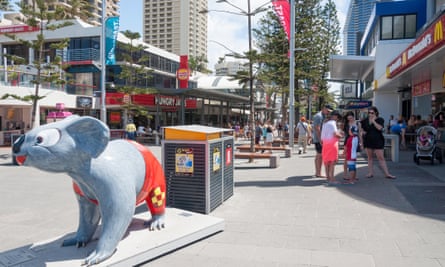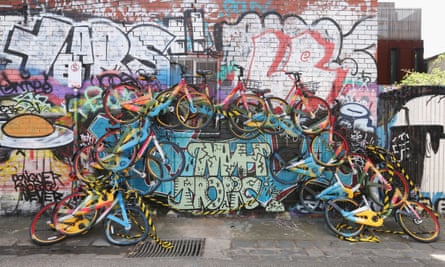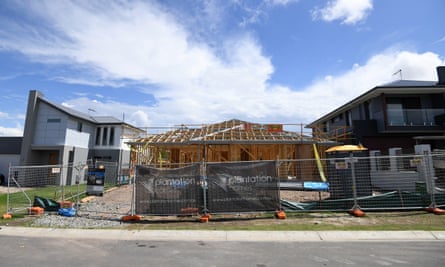“Growth is the conversation Melburnians are having – or want to have,” wrote Gay Alcorn in her feature on the city’s uncertain future, which launched Guardian Cities’ Australian cities week. Melburnians went on to prove her right.
Gay’s piece sparked a passionate and informed response, with nearly 1,000 comments discussing Melbourne’s rapid growth and changing character. One long-time resident wrote: “It is still a great place to live but is rapidly sleepwalking to a future where it will have lost so much and be unrecognisable.”
Judging by the response to our callout for readers’ experiences of Australian cities, and your hopes and fears for their future, it seems these conversations are being had across urban Australia. We received many more responses than we could feature, but each was read and appreciated, and may inform future commissions. Those below have been edited for length.
‘Sydney has too many eggs in its CBD basket’
Recent events such as the Harbour Bridge trespasser and a fatality at Burwood station, both of which brought Sydney to near standstill show how Sydney has too many eggs in its CBD basket. Other world cities are much more decentralised and public transport designed accordingly and more flexibility.
European cities house their residents at greater densities than the average for the Sydney basin without the excessive height of the apartments being imposed in many suburbs now. Why are those in power blind to what they can learn from these long-established cities?
‘The Gold Coast’s growth has been a rollercoaster ride’

I moved to the Gold Coast just over 10 years ago. Having spent most of my life living in English cities, I was taken aback by its newness and the stunning location. As the father of two teenaged boys, I came to look at the city as one going through its adolescent stage of development. Struggling with the growing pains of rapid urbanisation, not sure of its identity, prone to hubris and with a somewhat ambiguous attitude to sex and sexuality, the city could not be described as mature. But it was only around 50 years old – in city years, pretty young.
There have lately been clear signs that the city is growing up. It’s begun to think more seriously about its long-term future and to develop a persona beyond being famous for fun, laying the foundations for economic growth and cultural capital. To go from a collection of beachside villages to the sixth-largest city in the country has been a bit like the rollercoaster rides you can experience at our theme parks – but maybe now we’re shrieking a little bit less as we go. So long as the city can retain its youthful exuberance, its newfound maturity promises an exciting future. Prof Paul Burton, director of the Cities Research Institute at Griffith University
Canberra: already a 30-minute city
Canberra is something of an anomaly in Australia – a city which has been planned, almost down to each acre block, with large median strips for light rail and suburbs that fit in with the geographical landscape. If this good planning continues, Canberra will remain a 30-minute city for a long time to come. Jason Vettig, Canberra
‘I didn’t need to leave Brisbane to find home’
Brisbane has always been a place that I longed to escape from. The big cities of Melbourne and Sydney called me with (partially imagined) tantalising opportunities to remake myself and embrace a more vivid, cultured life. In my mid-20s, my shorthand for this was describing Melbourne as the European Australia and Sydney the London Australia. And yet five years later, nudging 30, I’m settled in Brisbane with a husband and a mortgage. The coffee here is better than Melbourne, and young people can live in a house bigger than a shoebox for a fraction of Sydney prices.
Brisbane is also growing in advocacy movements, the recent gay marriage rallies symbolising the final shaking off of the “Johburg”-era backwater town. Standing in a large happy crowd with a lei around my neck I realised that I didn’t need to leave to find home. Stewardship for the environment is also prioritised. I now light a candle that, as Brisbane grows, the focus will be on people and not profits: the ongoing fight for all Australian cities. Bethany Masters, Brisbane
‘Perth: one huge, puzzling opportunity’
Perth is strung out along the coast, and feels like it has no depth. Its centre is dead while its inner suburbs are vibrant. It is the perfect climate to walk and cycle, but few bother. It has a limited but effective public transport system, but people try to avoid it. It has endless stretches of pristine beaches, with nobody on them. I find Perth one huge, puzzling opportunity. Phil Wilkinson, Perth
‘Overpopulation is eating away at the quality of life in Melbourne’

Melbourne is a beautiful city, full of parks, open remnant bush, bay beaches. However, we are losing this environment as overpopulation eats away at the quality of life. Smog is noticeably worse than it was 10 years ago – I could taste the air today. There is less and less open space, as developers cram units on to spaces that used to hold only one dwelling. In my street, eight units were built on one block. The natural environment is disappearing – street trees die because their roots can’t get water – and the ground is covered in concrete. We all suffer: newcomers and those who have lived here for decades.
Immigration is generally a good thing for communities. However, untrammelled growth is not. We are currently governed by those who think only of short-term outcomes and not long-term consequences. The question has to be “How much immigration is sustainable for Australia?” and how should that be managed. Janet McColl, Melbourne
‘I’m alarmed by the denial of our climate future’
Excellent longer piece by @DeliaFalconer on the GSC’s three cities plan for Sydney, for @guardiancities https://t.co/xSgGcPXgI1
— Ben Harris-Roxas (@ben_hr) April 10, 2018
The best aspects are that it casts doubt on specious claims about three historical Aboriginal regions across Greater Sydney, and that there’s no allowance for climate change in the plans.
— Ben Harris-Roxas (@ben_hr) April 10, 2018
I’m alarmed about the denial of our climate future in the plan. Western Sydney is often the hottest place in Australia, and on occasion the world. Removing green space for housing and a huge concrete airport is not climate adaptation - it’s thermal misery.
— Ben Harris-Roxas (@ben_hr) April 10, 2018
Further, there are no historical antecedents for successfully building even a small city focused on an airport. The aerotropolis is a planning fiction so fanciful that a multi-function polis is a sound and sensible notion in comparison.
— Ben Harris-Roxas (@ben_hr) April 10, 2018
Hobart is more than Mona
As a young person under 30 living in Hobart, I love my lifestyle – the access to the outdoors and the scenery are fantastic. But lately it feels more and more like we are just props in a tourist show. Even your article for Hobart is about the Museum of Old and New Art (Mona) and how it pushes boundaries. Mona has put Hobart on the map, but it has also made it unliveable for so many of us by sparking a tourism boom that has exploded house prices and diverted rental housing to Airbnb.
I hope that Hobart, and Tasmania, can manage the ever increasing numbers of tourists who want to come and see the beautiful place we live in. But looking at other cities in Australia, Melbourne and Sydney in particular, I’m not confident that it will be done well. I think that a few people will make a lot of money and the rest of us will continue to be props in cruiseship holiday snaps. Anonymous, Hobart
‘The conservative brigade is ripping the soul out of this country’
Lock out laws in major centres and trends in attitudes that perceive nightlife, clubbing and attending live music as something almost taboo, are surely contributing to Australia's cultural decline?
It's so sad to watch. Australia had so much potential and was on a trajectory to being a global music and clubbing destination. The conservative brigade (including Christian political figures), greedy developers, visionless councils, and the nasty, selfish NIMBYs of Sydney, Brisbane and Melbourne, have ripped the soul out of this country.
Adelaide works hard for its wealth
Adelaide is on the edge of human habitability and economic sustainability, a precarious position that has inspired generations to cultivate an innovative, fun and beautiful city. Without the relentless growth of the east coast and the buried treasure of the west, Adelaide’s politicians and entrepreneurs have had to drive its prosperity – from the great landed families of the late-19th/early-20th century through to the modernisation under the recently departed Jay Weatherill government.
Adelaide works hard for its wealth, whether that is appropriating federal government ministries and funds or baiting private capital. We always appear to teeter on the edge of economic oblivion – a great if stressful motivator for the city and its people. With the economic and environmental sword of Damocles perpetually hovering over our collective heads – see the current state of the Murray river, and millennial drought – we get on with it and make sure that our city stays the most liveable and beautifully constructed city in Australia. James Johnson, Adelaide
This article includes content provided by Instagram. We ask for your permission before anything is loaded, as they may be using cookies and other technologies. To view this content, click 'Allow and continue'.
Indigenous people are still disadvantaged in Australian cities
The same displacement of Indigenous people by gentrification written about by Jack Latimore happened in Perth. Fifty years ago, East Perth had many Noongar households. Now they are not there, except on the street experiencing homelessness. Perth was declared a prohibited zone for Indigenous people in the 1920s; they needed a pass to go in to work in the city and if they had not left by 6pm they could be jailed. The area along the river in East Perth, where the rents were cheaper and there was unskilled work, became a refuge. Restrictions on the movement of Aboriginal people were lifted after 1954, but East Perth retained an Indigenous community of between 175 and 200 people throughout the 1960s, like a reserve in the city. The state did nothing to help them out of poverty or provide accommodation. A newspaper editorial blamed unaffordable rent and a shortage of housing: “We would like to think there is no poverty, and there are no underprivileged or disadvantaged people in this wonderful state, but this is not so. … Until the State Housing Commission build four-bedroomed houses and cut down the waiting list, there will continue to be disadvantaged people of this type.” Not dissimilar to issues being raised in Perth 50 years later. Stephen Hall, Shelter WA, Perth
Australia’s smaller cities are doomed to repeat its largest’s mistakes
Newcastle [160km (100mi) north-east of Sydney] is currently experiencing the process of growth and gentrification that I experienced in Sydney five years ago. Australia’s small cities provide an opportunity to do something different, yet, because of state control, we are forced to trundle down a path that has already proven a mistake. I fear Newcastle will end up in the same mess as Sydney. What I hope for is a different model – either as a regional centre, or as a regional outpost of Sydney supported by fast rail. Jenepher Surbey, Newcastle
Suburban Brisbane made me long for a latte

We moved to Brisbane in 1986 from Norwich when I was eight and I lived there for the next 19 years. I’ve always considered it “where I grew up”. My memories of childhood are of houses with big gardens, and I spent most of my time outdoors riding bikes, playing ball games, getting around barefoot. We didn’t lock the windows at night, and usually left the front door open. My parents bought a house in Norman Park, a quiet, typical suburb, for $60k in the late 80s. They sold it for $130k in the late 90s. It’s now worth around $850k.
I visited Brisbane a year ago and was reminded how beautiful, green, friendly and relaxed it still is. But this development of the inner city and suburbs has priced people out. My friends who still live there have bought big houses and gardens in the sprawling deep south and western suburbs, but there is no culture around them. No cafes. No art galleries. No bars. The city, its river, the music and the pulse of Brisbane are so distant they may as well be another city altogether. It’s flat, endless suburbia. I spent a weekend there and became so affected by ennui I had to mainline a latte. Brand King, Chilmark, UK
Melbourne is fading away into a bland haze
I have lived most of my life in Melbourne and like many people I don't like too much change and see the past through rose coloured glasses. It is still a great place to live but is rapidly sleepwalking to a future where it will have lost so much and be unrecognizable.
It is frightening how many hideous apartments are changing the charm and character of the inner city. Street art covers any old surface that hasn't been torn down. I must be the only one who laments the loss of old brick for the garish, intrusive coating character filled lanes and streets we used to have. Every event is over crowded to the point where it is too much hassle to take part. Exhibitions at the National Gallery have queues of people who will happily walk in front of of you to take selfies in front of painting and move on without looking at the original. Roads are clogged with traffic and drivers are increasingly aggressive and in desperate need of anger management classes. Commercial interests have made inroads into public spaces. Interesting alternative places and streets get discovered and the rich move in and the low income earners, artists and musicians move on to be shunted on again a few years later when their suburb becomes the next cool location and the rent goes up.
Best stop as my credentials as a grumpy old man are becoming glaringly obvious. A great city but it is fading away into a bland haze.
Low-density Canberra is ‘deathly dull’ – even depressing
Canberra is less a city than a series of low-density suburbs, with a population of 400,000 spread out over huge distances. This means that it’s extremely car dependent and decentralised, which makes it hard for culture to survive. The NewActon development was sold as a cultural precinct, but within a few months of people moving into apartments, noise complaints chased the “culture” away. Thus another part of the city was returned to being an eerie ghost town. The outdoor, pedestrianised City Walk should be lined with stalls, street food, music and buskers, but it is just completely empty – if you drop a pin, you can hear the echo.
The CBD is deathly dull. Nobody walks in Canberra because of the large distances between everything and, let’s be real, it has no real interesting architecture or environment. I’ve often been told by people who move here: “In Melbourne, I walked 10km a day; in Canberra, I drive 500m to go to the corner store.” You don’t see people doing anything outside. There is no life. This actually can make for quite a depressing atmosphere. Canberra could be a great city, but it needs to dump its extremely restrictive zoning and its nimby attitude, and embrace a complete urban rethink. Kaoru Azuma, Canberra
If you’re not a family person, Perth isn’t for you
Perth is a weird city: the capital of Western Australia, but low density, with a huge urban sprawl. The only reasons people stay here are family ties, the remoteness of Perth and a lack of nearby opportunities. Perth seems to be built around keeping rich, conservative families happy with their lot and little else. If you’re not a family person, there’s very little culture for you to connect with.
The lack of culture has always been a real problem for me. When I get an interest in something, in general I find that in Perth no one cares, or a tiny niche group does, but it’s a bit too insular for new members. This ranges from politics to arts to video games. I do worry that this city is doomed to be little more than a big town, due to overinvestment in tourist attractions, like Colin Barnett’s Elizabeth Quay, instead of the people that live here all year. Jonathon Morald, Perth
